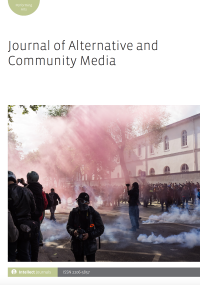Journal of Alternative & Community Media - Current Issue
Volume 7, Issue 1, 2022
- Articles
-
-
-
Breaking cultures of silence: Learnings from a participatory community-centred approach to leveraging and researching documentaries for social change
More LessThis article offers new learnings and recommended practices for documentary-centred grassroots engagement and social change research. These learnings were developed through a community engagement effort in 2020 that centred around a documentary film about racial violence and injustice, Always in Season. Shaped by extended dialogues with industry experts, the filmmaker, local community organizations and more than 100 community participants, these learnings should be of interest to researchers, media makers, organizers, activists, and engagement specialists who wish to engage publics in critical social justice conversations that are not possible through traditional top-down, externally driven methods and engagement approaches alone. Organized around an urgent question – ‘How can participatory methods shift how media is employed and researched for social change purposes?’ – this article responds to a recent call for researchers to avoid ‘re-inventing the wheel’ and to align new work with existing knowledge produced in the field of communication for social change and the long-tradition of community engagement work in the field of documentary.
-
-
-
-
The art of agitation: The nineteenth-century press activism of George Jacob Holyoake
More LessThis interdisciplinary study reconsiders nineteenth-century English newspaper editor George Jacob Holyoake’s paradoxical legacy. Drawing on Gramscian cultural hegemony theory, the study demonstrates Holyoake’s use of press activism to win liberal reforms, culturally empower the working class and articulate Owenist-socialism’s evolving counter-hegemony. In particular, it shows that his editorial agitations laid important discursive foundations for secularism, freedom of the radical press and the co-operative movement. Although Holyoake is frequently celebrated by secularists and co-operators alike for his leading role in their movements’ historic take-off, this article argues his alternative journalism decisively underwrote those campaigns. Against clerical, capitalist and repressive state power, his editorial labour thereby shaped the emergent, oppositional culture that transformed a pre-democratic Britain. Although Holyoake’s multiplex legacy has overshadowed his alternative journalism’s importance, this article thus illuminates his neglected role as an ‘organic intellectual’ of the English working class, an ‘integral journalist’ and an alternative media pioneer.
-
-
-
Public value of community media in Austria
More LessAuthors: Katharina Biringer, Helmut Peissl and Josef SeethalerThis article explores the public value of community media in Austria. Though they fulfil various important functions in civil society, they do not enjoy the same legislative recognition and financial funding like other public-value-generating broadcasters do. For this study five normative functions have been developed to measure the community media’s public value: the articulation function, the participation function, the complementary function, the media literacy function and the strategies in media convergence function. In thirteen focus groups with members of fifteen Austrian community media, the strong institutionalization of the sector became just as apparent as the existence of a commonly shared self-perception. The normative functions are strongly anchored in the daily routine of the participating programme makers. So, community media in Austria clearly generate public value.
-
-
-
Warming up: The potential of community radio for climate change communication in Australia
More LessAuthors: Kerrie Foxwell-Norton, Bridget Backhaus and Anne LeitchClimate change is already dramatically affecting the Australian landscape and way of life. These impacts are experienced locally, therefore responses must also be local, at least in part. There is an opportunity for Australia’s vibrant community radio sector to play a leading role in building community resilience around the effects of climate change. The importance of the sector in climate change communication is well-known: from emergency broadcasting during bushfires, to disaster preparedness and recovery work in cyclone season, as well as the activist role some stations take on local environmental issues. While important work is taking place, many stations lack the resources and the confidence to discuss how climate change is affecting their communities. This article details the findings of Warming Up, a pilot research project that aims to support community radio stations by amplifying local stories of climate change and building confidence and capacity to engage in meaningful community conversations.
-
-
-
Breaking the link: Film pedagogy and drug policy in the United Kingdom
More LessAuthors: Anthony Killick and Lee SalterFifty-one years ago the UK government passed the Misuse of Drugs Act, establishing the three-tier drugs classification system that remains largely unchanged to this day. Since that time, representations of drugs and drug users in the media have fuelled (if not entirely fabricated) moral panics to which political actors are happy to respond, rather than engaging with more evidence-based yet publicly controversial solutions. The result is a link between drug policy and media representation that is characterized by ‘moral panic’ public outrage and knee-jerk government responses that are resistant to scientific evidence and the testimony of drug users. This article focuses on the ways in which some filmmakers have developed practices that aim to undermine the dominant hegemonic representation of drugs and drug users through airing discourses that are grounded in harm reduction, rather than criminality. We highlight the ways in which harm reduction discourses can be represented to verify and justify normalized policy positions centred on crime and punishment, or can be promoted through a selection of pedagogical filmmaking strategies that facilitate the testimony of drug users. We argue that certain filmmaking strategies confer possibilities for breaking the link between harmful drugs policy and simplified media representations of drugs and drug users.
-
Most Read This Month Most Read RSS feed


